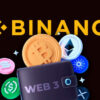
How Decentralized Platforms are Reshaping Traditional Business Models
In recent years, the rise of decentralized platforms has ignited a profound transformation in the business landscape. These innovative technologies, primarily driven by blockchain and smart contract systems, are challenging the very foundations of traditional business models.
In this article, we will delve into the remarkable ways decentralized platforms reshape industries, redefine trust, and offer new avenues for efficiency, transparency, and autonomy.
From the emergence of decentralized finance (DeFi) to tokenizing assets and the advent of decentralized autonomous organizations (DAOs), this paradigm shift is ushering in an era of unprecedented change, reimagining how businesses operate, collaborate, and thrive in an increasingly interconnected world.
Key Concepts
Here are some key concepts related to how decentralized platforms are reshaping traditional business models:
- Blockchain Technology
- Smart Contracts
- Decentralized Finance (DeFi)
- Tokenization
- Supply Chain Management
- Decentralized Autonomous Organizations (DAOs)
- Regulatory Hurdles
- Security Risks
- Scalability Issues
Blockchain Technology
Blockchain is a distributed ledger technology that underlies decentralized platforms. It’s a tamper-proof, transparent, and decentralized way of recording transactions and data.
Smart Contracts
Smart contracts are self-executing contracts with the terms of the agreement directly written into code. They automate and enforce contractual agreements, reducing the need for intermediaries.
Decentralized Finance (DeFi)
DeFi refers to financial services and applications built on blockchain technology. It includes lending, borrowing, trading, and more, all without traditional banks or financial intermediaries.
Tokenization
Tokenization is the process of converting rights to an asset into a digital token on a blockchain. It makes assets like real estate, art, and stocks more accessible and divisible.
Supply Chain Management
Through blockchain technology, decentralized platforms are revolutionizing supply chain management by providing transparency, traceability, and efficiency.
Decentralized Autonomous Organizations (DAOs)
DAOs are organizations governed by smart contracts and token holders, enabling decentralized decision-making and management without traditional corporate hierarchies.
Regulatory Hurdles
The adoption of decentralized platforms faces challenges related to regulatory compliance as governments grapple with the novel nature of these technologies.
Security Risks
Security is a concern due to the irreversible nature of blockchain transactions and the potential for vulnerabilities in smart contracts.
Scalability Issues
Scaling blockchain networks to handle a high volume of transactions while maintaining decentralization is an ongoing challenge.
These concepts form the foundation for understanding how decentralized platforms disrupt and reshape traditional business models.
Decentralized Finance (DeFi)
Decentralized Finance, often called DeFi, is a revolutionary financial ecosystem built on blockchain technology. Here are some key points about DeFi:
- Financial Services on Blockchain
- Eliminating Intermediaries
- Accessibility
- Liquidity and Yield
- Tokenization
- Decentralized Exchanges (DEXs)
Financial Services on Blockchain
DeFi encompasses various financial services operating on decentralized blockchain networks, including lending, borrowing, trading, and asset management.
Eliminating Intermediaries
DeFi aims to eliminate traditional intermediaries, such as banks and financial institutions, by allowing users to interact directly with smart contracts and decentralized applications (dApps).
Accessibility
DeFi makes financial services more accessible to a global audience, including those who are unbanked or underbanked, by requiring only an internet connection and a compatible wallet.
Liquidity and Yield
Users can earn interest, often called “yield farming,” by providing liquidity to DeFi protocols. This liquidity is utilized for lending and trading within the DeFi ecosystem.
Tokenization
Assets like cryptocurrencies, real estate, and even art can be tokenized on blockchain networks, making them more easily tradable and divisible.
Decentralized Exchanges (DEXs)
DEXs facilitate peer-to-peer trading of cryptocurrencies without the need for a centralized exchange. They are a core component of the DeFi ecosystem.
DeFi is reshaping traditional finance by offering a more open, transparent, and inclusive alternative. However, users need to exercise caution and conduct thorough research due to the experimental nature of many DeFi projects.
Tokenization
Tokenization is a transformative concept in finance and assets, often associated with blockchain technology. Here’s a closer look at tokenization:
Definition
Tokenization involves converting the ownership or rights to an asset, whether physical (like real estate) or digital (like stocks), into a digital token on a blockchain.
Digital Representation
Each token represents a portion of the asset’s value or ownership. These tokens are stored on a blockchain, making them secure, tamper-proof, and easily transferable.
Asset Types
Tokenization can be applied to various assets, including real estate properties, artworks, stocks, bonds, commodities, and intellectual property rights.
Fractional Ownership
Tokenization enables fractional ownership, meaning high-value assets can be divided into smaller, more affordable shares. This opens up investment opportunities to a broader range of investors.
Liquidity
Tokenization enhances liquidity by allowing assets to be traded 24/7 on blockchain-based marketplaces. This contrasts with traditional markets, which often have limited trading hours.
Transparency and Security
Blockchain’s transparency and security features make it possible to verify ownership and track the history of asset transactions, reducing fraud and disputes.
Global Accessibility
Tokenized assets can be bought and sold by anyone with an internet connection and a compatible wallet, breaking down geographical barriers.
Smart Contracts
Smart contracts can be integrated with tokenized assets to automate functions such as dividend distribution, voting rights, and compliance with regulatory requirements.
Regulatory Considerations
Tokenization may require compliance with securities regulations and other legal frameworks, depending on the asset and jurisdiction.
Challenges
Challenges include ensuring tokenized asset security, establishing regulatory clarity, and addressing scalability issues on blockchain networks.
Tokenization has the potential to democratize access to assets and revolutionize traditional financial systems by making ownership and trading more efficient, transparent, and inclusive. However, it’s an evolving field that requires careful consideration of legal and technical aspects.
Supply Chain Management
Supply chain management is critical to modern business operations, and decentralized platforms and emerging technologies like blockchain significantly impact it. Here are some key points about supply chain management in this context:
- Traditional Supply Chain Challenges
- Blockchain’s Role
- Traceability and Transparency
- Reducing Counterfeits
- Smart Contracts
- Supply Chain Finance
- Interoperability
Traditional Supply Chain Challenges
Traditional supply chains often suffer from inefficiencies, lack of transparency, and the involvement of numerous intermediaries, making it difficult to trace products from source to destination.
Blockchain’s Role
Blockchain technology is being employed to create transparent and tamper-proof supply chains. Each step in the supply chain can be recorded on a blockchain, ensuring trust and visibility.
Traceability and Transparency
Blockchain enables end-to-end traceability, allowing companies and consumers to track the journey of products. This is particularly important for verifying the authenticity of products and ensuring compliance with regulations.
Reducing Counterfeits
With blockchain, it’s much harder to produce counterfeit products or insert fake goods into the supply chain, as every transaction is recorded and immutable.
Smart Contracts
Smart contracts can automate various aspects of supply chain management, such as triggering payments when goods are received or verifying that conditions (like temperature or humidity) were maintained during transportation.
Supply Chain Finance
Blockchain-based supply chains can facilitate quicker and more efficient supply chain finance solutions, benefiting suppliers and buyers.
Interoperability
To maximize the benefits of blockchain in supply chain management, interoperability between blockchain networks and legacy systems is a challenge that needs to be addressed.
Blockchain and decentralized platforms revolutionize supply chain management by providing transparency, traceability, and efficiency.
They promise to reduce fraud, waste, and inefficiency in supply chains while improving the overall reliability and sustainability of products and services. However, challenges remain in terms of widespread adoption and ensuring data security.
Decentralized Autonomous Organizations (DAOs)
Decentralized Autonomous Organizations (DAOs) are a groundbreaking concept in decentralized platforms and blockchain technology. Here’s a closer look at DAOs:
Definition
DAOs are organizations represented by rules encoded as computer programs (smart contracts) that run on a blockchain. These rules dictate how the organization operates and makes decisions, typically without centralized control.
Autonomous Decision-Making
DAOs aim to replace traditional hierarchical management structures with code-driven decision-making processes. Token holders typically vote on proposals or changes to the organization’s rules.
Token-Based Governance
DAOs often have a native cryptocurrency or token that grants voting power to its holders. The more tokens a member holds, the more influence they have in shaping the organization’s decisions.
Transparency and Trust
DAOs operate on a public blockchain, making all transactions and decisions transparent and immutable. This enhances trust among participants.
Use Cases
DAOs have many applications, from managing decentralized finance (DeFi) protocols to governing digital art marketplaces or making collective investment decisions.
Risks and Challenges
- Security vulnerabilities in smart contracts can lead to unexpected outcomes or loss of funds. The 2016 “The DAO” hack is a prominent example of such risks.
- Legal and regulatory frameworks for DAOs are still evolving, creating uncertainty in some jurisdictions.
- DAOs often require a strong community and active participation to make effective decisions.
Evolution
DAOs are continuously evolving, with improvements in mechanisms for decision-making, dispute resolution, and token-based incentives.
Examples
Notable examples of DAOs include “MakerDAO,” which governs the stablecoin DAI, and “Uniswap,” an automated decentralized exchange (DEX).
Collective Governance
DAOs represent a shift towards collective governance, where decisions are made by a decentralized community of stakeholders rather than a centralized authority.
Future Potential
The potential for DAOs to disrupt traditional organizations, reduce bureaucracy, and create new forms of collaboration is significant, but their success depends on addressing security and legal challenges.
In essence, DAOs represent a paradigm shift in organizations’ operations, enabling trustless and autonomous decision-making among a distributed group of stakeholders. While they hold great promise, the technology is still relatively young, and the space continues to evolve.
Challenges and Concerns
Decentralized platforms and technologies like blockchain and decentralized finance (DeFi) bring significant benefits, challenges, and concerns. Here are some key challenges and problems associated with these innovations:
- Regulatory Hurdles
- Security Risks
- Scalability Issues
- User Experience
- Interoperability
- Volatility
- Lack of Consumer Protection
Regulatory Hurdles
Regulatory frameworks for decentralized platforms are still evolving, leading to uncertainty for businesses and users. Compliance with varying international laws can be challenging.
Security Risks
Smart contract vulnerabilities can lead to hacks and the loss of funds. The immutability of blockchain can make it challenging to reverse transactions or recover assets in case of security breaches.
Scalability Issues
Many blockchain networks face scalability challenges, such as slow transaction processing times and high fees during network congestion. This limits their ability to handle large-scale adoption.
User Experience
Decentralized platforms often have complex user interfaces, making them less user-friendly than traditional centralized counterparts. Improving user experience is crucial for broader adoption.
Interoperability
Different blockchain networks often operate in isolation, hindering interoperability. This limits the seamless transfer of assets and data between other platforms.
Volatility
Cryptocurrencies, which underpin many decentralized platforms, are known for their price volatility. This can pose risks for users and investors.
Lack of Consumer Protection
Traditional financial systems offer consumer protection mechanisms like insurance and regulatory oversight. Decentralized platforms may lack these safeguards, putting users at risk.
Addressing these challenges and concerns is essential for decentralized platforms’ continued growth and adoption. It requires collaboration among industry stakeholders, regulators, and innovators to balance innovation and risk mitigation.
Future Trends
The future of decentralized platforms and blockchain technology will be dynamic and transformative. Here are some key trends to watch for:
- Interoperability
- Layer 2 Solutions
- Cross-Chain Functionality
- Decentralized Identity
- NFT Innovation
- DeFi Evolution
- Regulatory Clarity
- Energy-Efficient Blockchain
Interoperability
Projects focused on bridging different blockchain networks and enabling seamless communication will gain prominence, allowing for a more interconnected blockchain ecosystem.
Layer 2 Solutions
Scalability solutions like Layer 2 (L2) networks and sidechains will become essential for blockchain networks to handle more transactions efficiently and cost-effectively.
Cross-Chain Functionality
More projects will work on facilitating the movement of assets and data across different blockchains, reducing reliance on a single network.
Decentralized Identity
Decentralized identity solutions will emerge, giving users greater control over their personal information and reducing reliance on centralized identity providers.
NFT Innovation
Non-fungible tokens (NFTs) will continue to evolve beyond digital art, finding applications in gaming, virtual real estate, and unique digital experiences.
DeFi Evolution
DeFi will expand to cover traditional financial services such as insurance, lending, and derivatives trading, further challenging traditional finance.
Regulatory Clarity
Governments and regulators will provide more precise guidelines for blockchain and cryptocurrencies, which will help legitimize and drive institutional adoption.
Energy-Efficient Blockchain
The environmental impact of blockchain, especially proof-of-work systems, will be addressed with the development of more energy-efficient consensus mechanisms.
These trends represent the evolving landscape of decentralized platforms and blockchain technology. As the technology matures and addresses current challenges, it will continue to disrupt various industries and shape the future of digital innovation.
Conclusion
Decentralized platforms and blockchain technology are at the forefront of a profound transformation in how we conduct business, exchange value, and govern organizations. These innovations are reshaping traditional business models in remarkable ways.
In this era of digital disruption, the potential of decentralized platforms is vast, offering opportunities for increased transparency, efficiency, and inclusivity across various sectors.
However, it’s essential to navigate the challenges and uncertainties while fostering collaboration among stakeholders to realize the full potential of this transformative technology. The journey toward decentralized innovation is ongoing, and the landscape will continue to evolve in exciting ways.





